Someday in the not terribly distant future, I will realize a long-held dream: I will set sail, alone, in a boat I have built myself, on a west-to-east voyage across the Atlantic Ocean. The boat will be a version of a cat-yawl I’ve already built and sailed, with some important modifications: it will have a single square-rigged sail; it will not have a rudder; it will be 31″ long, with a 12″ beam. Me? I’ll lie snug below for the entire voyage, however long it may last. I’ll be dead, reduced to a few pounds of ashes, stowed below deck in the cabin.
People weaken with age; dreams don’t. I’m 84 years old, in pretty good health, with enough marbles left to know that I shouldn’t make plans that extend too far into the future. No regrets; I’ve lived a full life, and it’s still an ongoing pleasure.
When I started building boats as a pastime almost 30 years ago, I thought a solo transatlantic voyage in a home-built hull would be a nice project. I did my research: I admired Blue Moon—the Thomas Gillmer 23′ gaff-rigged yawl—enough to contact someone who had built one. But it would have been a bad choice; I would probably be still planking it today.
I settled on Iain Oughtred’s 22′ Grey Seal, which I thought had the bones and stones for the passage. I had built his 14′ Whilly Boat, a superb design that offered good lessons for building Grey Seal. I talked to Iain, and he didn’t try to dissuade me. He did suggest building the centerboard rather than the keel version; he thought it might slide down the face of a wave better. Maybe that was meant to dissuade; it didn’t.
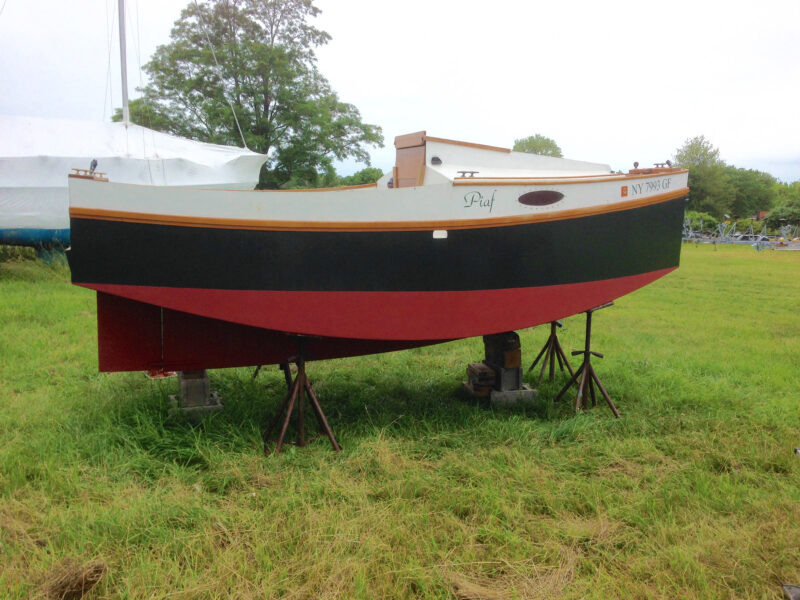 Photographs by the author
Photographs by the authorPIAF, the Phil Bolger Micro I built a few years ago, was the inspiration for CROW, the scaled-down boat that will carry my ashes to sea. The design offered a nice combination of simple construction and ample space for gear and passengers—and it sailed well.
The plan quickly ran onto a shoal: My wife thought it was unwise; still does and never will be persuaded otherwise while I’m alive. I understand. She was and is quite reasonably concerned that the voyage might kill me. But a thought came to me: What if I were already dead? No risk. No worry. That got her hesitant assent.
Though I was free to scheme, I put it off for a decade or so: Who thinks about dying when the wind’s fresh, the sea beckons, and there are other boats to build? But advancing age at last got me thinking. I won’t call old age a curse—it’s interesting if you take it the right way—but as Bette Davis observed, it’s not for sissies. Strength goes, pain arrives. There’s an Irish saying, “Death is the poor man’s doctor.” Death is also the old man’s inevitable companion; decent company, though, if you wish him to be.
As these thoughts arose, I finally turned to the task. I found there was much to plan. First, the boat. It would have to carry about 5 lbs of ashes, which would take up about 200 cubic inches—about the same as a six-pack of beer. It would have to be carried by hand, because I was planning to have it taken aboard a boat and launched as far offshore as possible—out from Montauk or, better, the elbow of Cape Cod—to give it the best chance of clearing North America. And it would have to be simple to build. I work slowly.
I thought it best to find plans for a full-sized boat and adapt them to my needs. It took about five minutes to realize that Grey Seal was not going to be the solution. I had taken Paul Gartside’s excellent course on boat design at WoodenBoat School and remembered that every vessel is a symphony of physics—it cannot have sour or misplaced notes. Shrink a 22′ lapstrake hull to a tenth of its length? Think about it if you wish, but don’t hope to send it across an ocean.
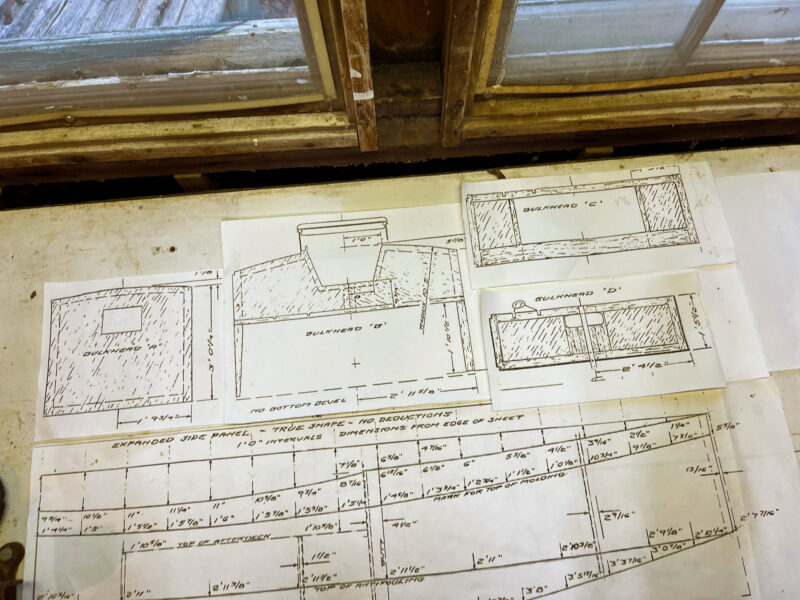
The original Micro plans, copied at twice the original size, gave me patterns that only needed to be traced and cut out for CROW. I modified bulkheads B, C and D to create a single enclosed “cabin” under a slightly raised cockpit deck.
But I had to come up with something. As it turned out, someone already had: Phil Bolger, he of Boats with an Open Mind. He called it Micro. I had, in fact, already built Micro—twice. One was full-size—15′4″ long with a 6′ beam and a cat-yawl rig. The other was a 1:12 scale model.
The full Micro and the model were (as our British friends say) a doddle—an easy task. Micro’s hull is a box, sides plumb to the bottom, shaped around four bulkheads to meet bow and stern transoms. For the model, I simply traced the parts from the 1″-to-1′ plans onto basswood sheets and glued them together. Building the full-sized Micro was the same process, just on a larger scale. I built it alone, only needing help to turn the ballasted hull right-side up to build the deck and interior. There came a time when I was able to lie below in the unfinished cabin and imagine evenings at distant docks or anchorages. It was deeply satisfying. Fifteen such minutes would refresh me, send me back to building with a new enthusiasm.
Something similar happened when I began planning my posthumous voyage. I found myself imagining the passage, feeling the boat’s roll and pitch, hearing the thunder of a breaking wave, the quavering note of wind in the rigging. If the weather worsened, I thought, what should I do?
At first, I laughed at myself: I would not even have a finger to lift to help my boat. I would be ashes. But I allowed myself to think: Might I be an observer? I am agnostic about the afterlife, though I incline strongly to the belief that The Big Sleep is much more likely than The Heavenly Choir. And yet…
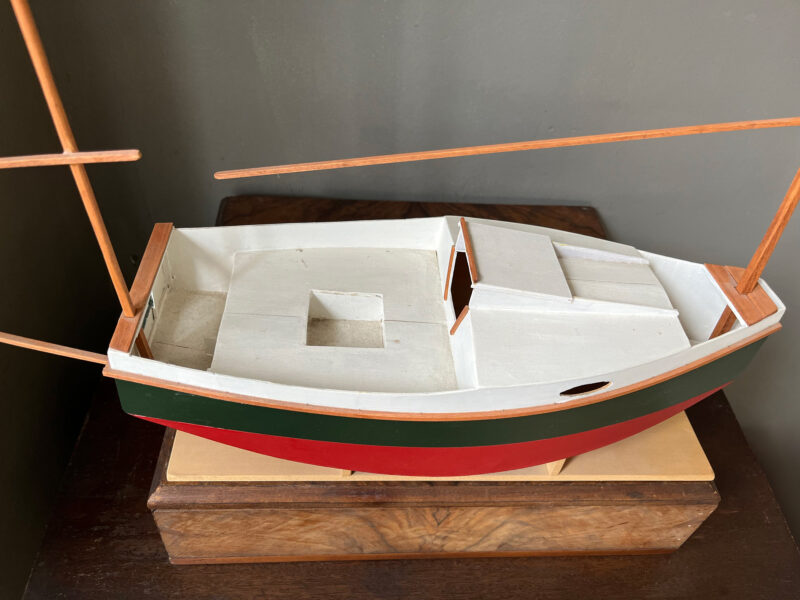
I had already built this 1:12 model Micro, half the size of CROW. It shows the open wells fore and aft in Bolger’s design. I decked these over in CROW to create flotation chambers.
Some months ago, I was talking to a close friend in his last hours.
“Frank,” I said, “if you find anything on the other side, try to send me a message. Make it about…”—I thought of our mutual fondness for birds—“Make it about crows.”
Later, after he was gone, I received a posting in my inbox by an artist I didn’t know and had never heard of. It was a picture of three crows. The title was, “Dark Angels.” When we put Frank’s ashes in the ground, six crows arrived and sat on the church steeple. When our little ceremony ended, they left.
Proof? Certainly not. But it did give me license to think about the voyage in a different way: as a participant. Which meant that I really owed it to myself to optimize chances for success. And it gave me a name for the boat: CROW. This fit well with my big Micro’s name: PIAF, French for sparrow.
Micro checked a lot of the necessary boxes: It would be easy to build a robust version with enough room below for my remains. I took my old plans to a copy center and had them printed double size to make the hull about 31″ long and 12″ wide. I traced the sides onto 1⁄8″ okoume plywood; I used 1⁄4″ okoume for the bulkheads and transoms.
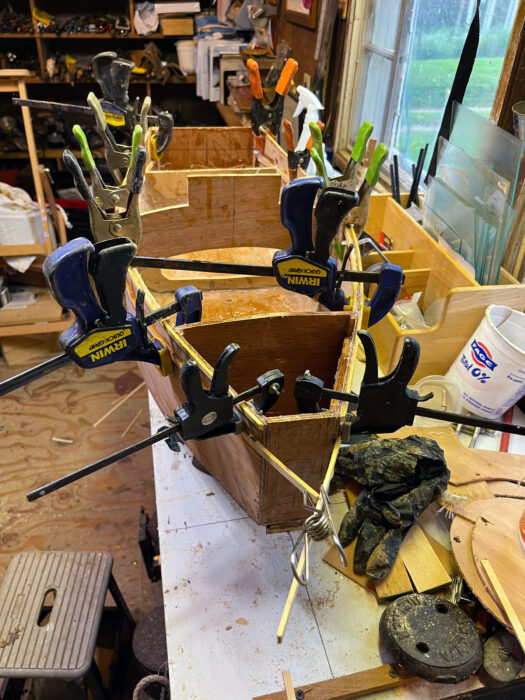
Even models demand a lot of clamps. Here, CROW gets her rubbing and sheer-strakes. These have a structural role in both the full-sized Micro and the model.
I altered the bulkheads to maximize cabin volume. On the real boat, the cabin is a 6 ½′-long space between the first and second bulkheads, A and B on the plans. Aft of the cabin is a space under the cockpit defined by the second, third, and fourth bulkheads—B, C, and D. Forward of A, and aft of D, are open wells.
First, I partially cut back the second and third bulkheads—B and C—to create an open cabin space about 21″ inches long. By raising the cockpit deck—no one was going to be leaning back against the sides—I got about 220 cubic inches of space below. I replaced the cockpit footwell with an 8″ circular plastic hatch, giving access to the now-enlarged “cabin” below.
I extended the cockpit deck over the aft open well to create a flotation chamber and decked-over the forward well to serve as a mast partner with flotation under. The undecked hull went together with fillets of thickened epoxy and strips of 6-oz fiberglass cloth. I epoxied wood strips in place to support the decks.
To be honest, the inside of the boat is not pretty. It was awkward to work in the confined space, and I had other fish to fry; I rushed the work. If I were to build another, I could and would make it nicer. But who needs a second coffin? This hull is sturdy and watertight. It will serve.
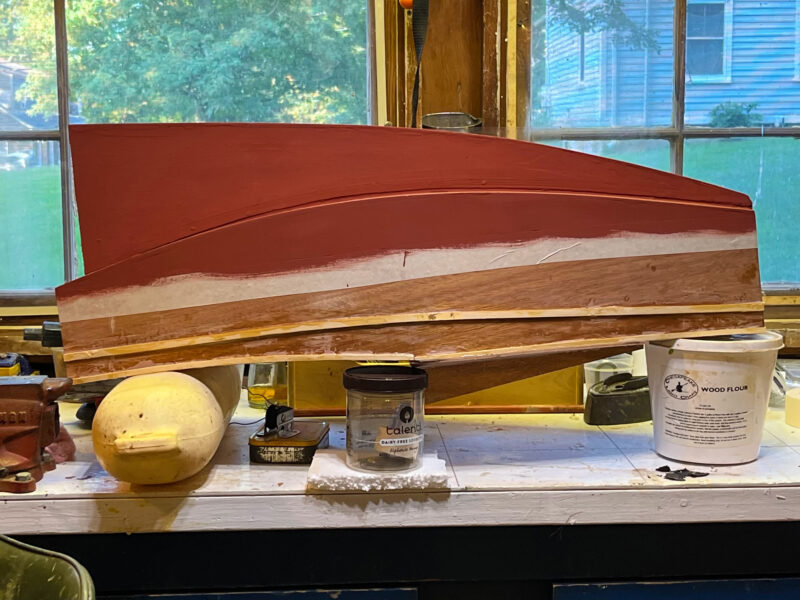
CROW may spend a long time at sea, so she wears a coat of ablative bottom paint. Changes to the underbody are evident: The Micro’s long, shallow keel runs twice as deep on the model, and there’s no rudder. CROW will run downwind, period.
At this point, I had solved the easy problem of how to build the containment vessel, but now I faced a much more daunting task: figuring out how to get it across an ocean. I thought first—please don’t laugh—of rigging CROW as a cat-yawl, just like its big sister. I spent rather too much time studying self-steering systems for model boats. They exist and have the same limitation that such systems have on big boats: they are slaves to the wind. If it changes, they alter course with it. They are elegant in design, but they’re complex and have moving parts that can fail.
Eventually, I bowed to some incontrovertible facts: the little Micro would have to submit to nature. It would be at the mercy of the winds and currents; it could only go where they sent it, when they sent it. This was not a killer problem for a west-to-east passage across the Atlantic. Despite global warming, the Gulf Stream is still running, and for much of the year the prevailing winds are out of the west. It is sometimes suggested that all one needs to do to make the crossing is to bring enough food and water, stay afloat, be patient and let nature take its course. I wouldn’t need food, water, or even patience.
Hence the squaresail—with no running sheets or braces—and the modified keel. The sail is small, of 1.9-oz ripstop nylon, set on carbon-fiber-tube yards lashed to a carbon-fiber-tube mast. I have some reservations about the carbon fiber; it is very rigid and very strong. I spent some of my youth as a merchant seaman; I went through three Pacific typhoons, and I know the sea can be…difficult. Even if CROW can run, pitchpoling is possible, and I do have fears that the rig might wrench or lever-apart the hull. In that case—hello, abyss. I’ll end up under two miles or so of water. Can’t be helped.
Bolger’s Micro has a long, shallow keel with 412 lbs of lead ballast. For CROW, I designed a keel that, in profile, looks more like a Friendship sloop: shallow forward, deep aft. Built to Bolger’s lines, the model would draw 3 1⁄2″. My modifications give it a 7 1⁄4″ draft.
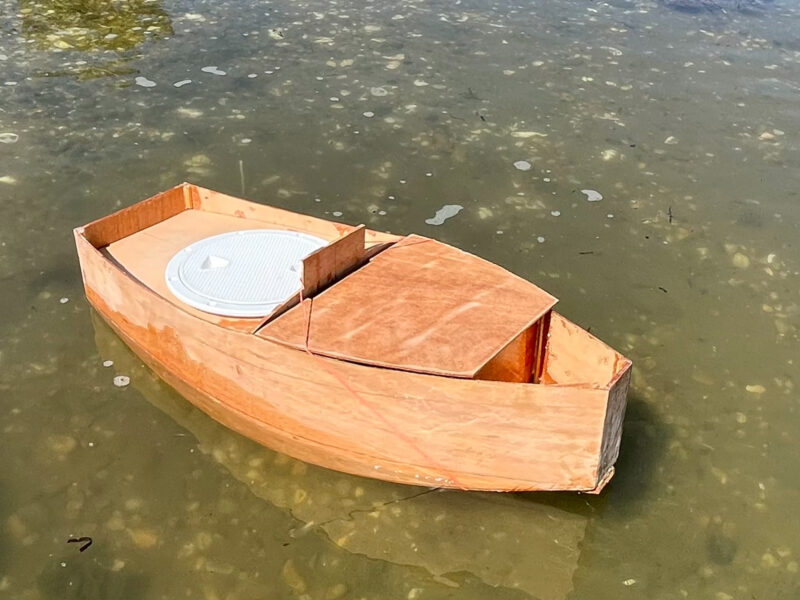
I also modified CROW’s decks, keel, ballast, and rig to make her fit for purpose. As soon as the hull was partly assembled and ballasted, I loaded in 6 lbs of lead “cargo”—the expected weight of my ashes—and set her afloat to check trim.
The idea is to keep her sailing downwind. If the wind falls and current takes over, CROW will, in my thinking, turn to breast the current and drift. If it’s wind against water, I’d be surprised if the result were a perfect balance. More wind, she sails; more current, she drifts. We’ve all sailed backwards against real-life tides at one time or another. When it happens to CROW, it’s not likely that I’ll care.
The real Micro’s ballast is a lead slug, shaped and sandwiched inside a box keel. When I built my full-sized Micro, I didn’t want the bother of casting lead. I thought and calculated a lot and decided to make the keel box wider and to use recycled lead shot set in epoxy instead.
It worked, so I used the same system with CROW: a lead-ballasted box, wider than the plan. Like its big sister it has lead shot set in epoxy but carried low in the box rather than up against the boat’s bottom. The ballast shape in profile resembles but doesn’t match the plan; I had to calculate how much the new keel would displace and rejigger the ballast placement to keep CROW on her waterline.
I am an overthinker. I recently found my planning notes for a weeklong hot-showers circumnavigation of Deer Isle I did by kayak some years back. I had to laugh at myself. The notes didn’t cover tsunami or meteor impact, but they did cover everything else.
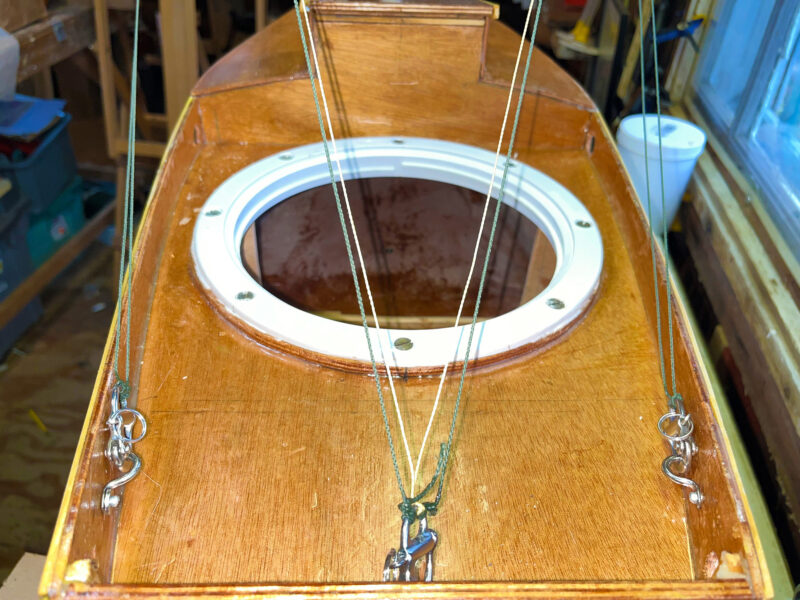
The cockpit from aft, with a look into the cabin. There’s no running rigging; Kevlar-cord sheets are doubled, fixed and fastened to pad-eyes port, starboard, and amidships. Port and starboard control a lower yard; amidships an upper yard.
As I was overthinking CROW’s ballasting, I realized I was planning—well, overplanning—for events that could have no effect on me. Nothing was going to make me more dead than I would already be.
Did this change my approach? Not in the least. I was solving problems in the here and now that could only strike in the by and by. I was doing everything I could to get a boat across a vast and often angry ocean. I had my hands and wits, a few tools, some epoxy, fastenings, cloth, wood, and carbon tubes. Would I win out against the Atlantic? It didn’t matter. I was again enjoying the great gift of boatbuilding—of always having a sweet problem to solve. Who among us hasn’t drifted off to sleep on that tide of thought?
One lesson that boatbuilding—and boating itself—reinforces is that problems often don’t have or need perfect solutions. For the after end of the keel, I could have brought the sides together in a fair trailing edge, as one naturally would with a rudder. But this would have made calculating the keel’s volume and geometry—and hence its displacement and required ballast weight and placement—more complicated. So, after some bedtime thought, I just squared off the keel aft, drag be damned. I won’t be in a rush to get wherever I’m going.
This willingness to compromise reached its peak in the rig, where I jettisoned thousands of years of sail evolution in the interest of simplicity and durability. No elegant curve between the clews for CROW; the foot of the sail is rolled and glued around the lower yard, as is its head. The leeches are reinforced with 100-lb test Kevlar cord and are glued with Gorilla fabric glue, which impressed me with its tough, waterproof bond. There will be little belly in the sail for the wind to fill. It will be a surface with a non-compound curve.
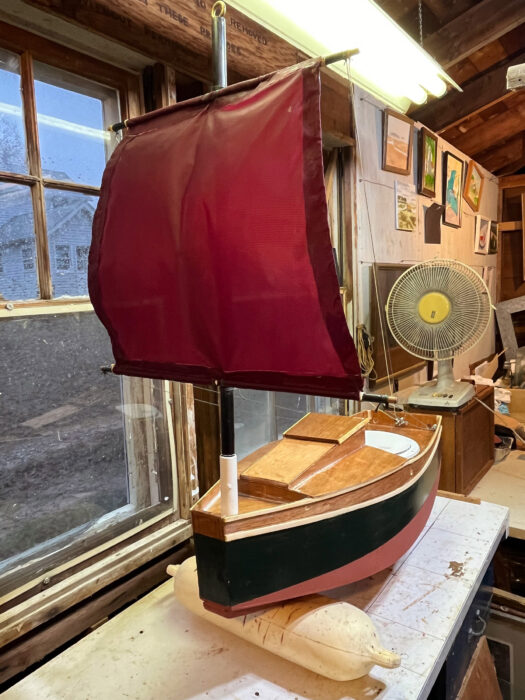
Under full sail, thanks to an electric fan. The original idea was to paint CROW’s decks and house white, but the okoume looked so good in its natural state that I decided on varnish.
And yet, this should serve. The sail won’t be asked to assume a complex shape for sailing closehauled. All it need do is run downwind. To arrange this, I pop-riveted small pad-eyes inside the bulwarks near the stern transom. I’ll fasten fixed-length sheets of Kevlar cord here from the ends of the lower yard—doubled, in case one carries away. Same aloft, to a centered deck pad-eye.
CROW’s first sea trial was makeshift. Because the rig’s weight is inconsequential—mast, yards, and sail together weigh 7 oz— as soon as I had the keel fastened, I put 6 lbs of lead in the cabin, put the hatch and cabintop in place, and set her afloat in Coecles Harbor, Shelter Island, at the east end of New York’s Long Island. She floated on her lines as she should, a bit down at the stern because of the absent rig and haphazard cargo stowage.
This encouraged me to finish the boat with some leftover bottom and topsides paint, red below and green above, like her big sister. I had planned for white decks and cabintop, but the natural okoume looked so good I slapped on some varnish. Overall, it’s a decent 4′, maybe 3′ finish: get any closer and my haste will be evident.
A second sea trial with rig, sail, and proper stowage resolved all doubts: CROW sat to her marks and, yes, sailed before the wind to the end of a tether. (I used Bolger’s design waterline, wondering only later if that, too, needed rethinking. We—or rather you—will see.) Wind vs. current tests will be done later in an operational setting, with me aboard.
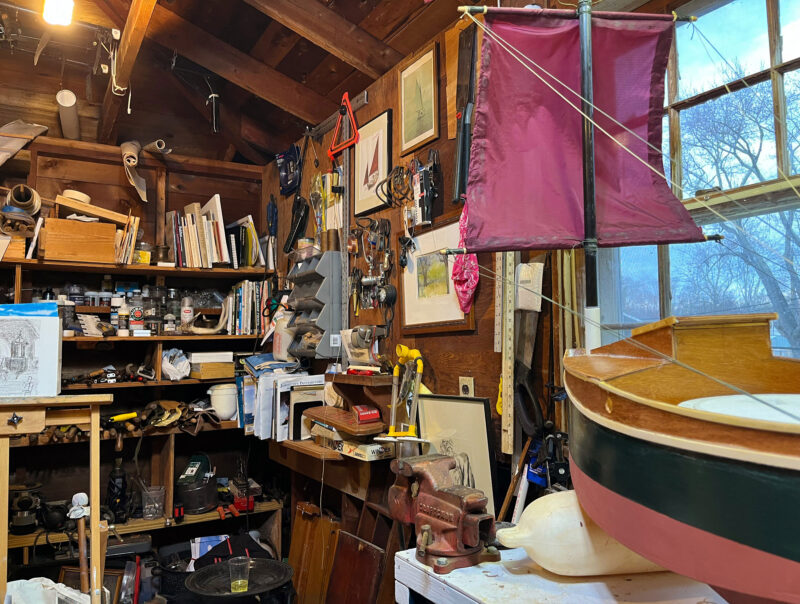
CROW holds course in my workshop/studio—about two-thirds of the space is for boatbuilding, the rest is for painting and graphic arts. A sampling of my art is on Instagram @drewfetherston. Building a boat is easier than drawing one.
If the eventual voyage goes well, my hope is that CROW will be found on some distant shore, and that my survivors will learn who found it, where and when. To encourage this, I wrote a note to be put in the cabin:
This boat contains the ashes of Andrew Fetherston, 1939–20___, of New York. Please scatter them near where you stand. The boat was launched from the East Coast of the United States on __________, with the hope that it would cross the Atlantic Ocean. You will find half of a $100 note. If you inform the persons named below where and when you found the boat, they will send the other half. They will also pay you a fee and all shipping costs to send the boat hull back to them, if you wish to undertake the task. Contact them for details. Thank you.
Using Google Translate, I made copies of this note in 13 languages, covering all countries bordering the North Atlantic from the United States across and down to West Africa: English, French, Danish, Icelandic, Norwegian, Irish and Scots Gaelic, Dutch, Frisian, German, Spanish, Portuguese, Arabic and on down the African coast to Dakar.
There remains a very big IF: the boat must be found, and the request understood and answered. There is a lot of history about such voyages, and the odds don’t favor success. People have been setting notes afloat since bottles were invented, and the rate of response in the North Atlantic region is about 3%. Lucky American bottle-tossers sometimes hear back from European finders in a matter of weeks. Others take longer. Much longer. Some spend more than a century in the water, waiting to be discovered.
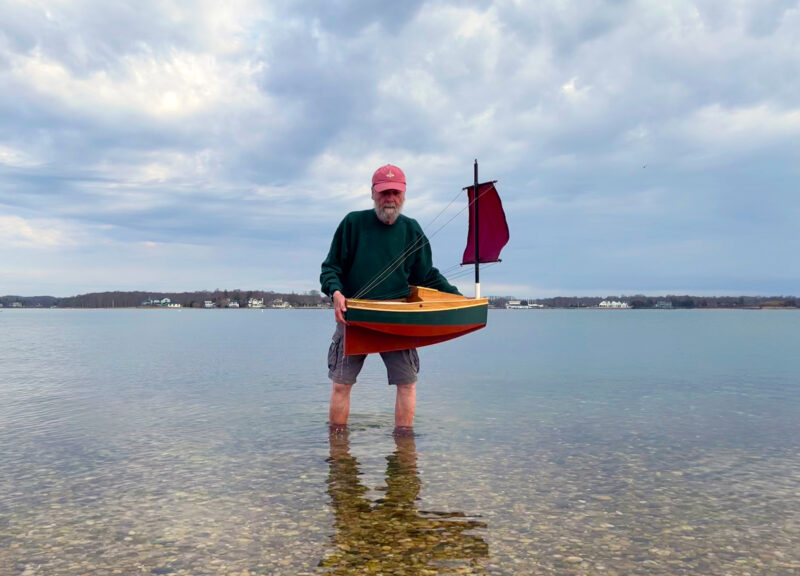
The first true sea trial, in the chilly late-winter waters of West Neck Harbor on Shelter Island, NY. Seventeen pounds empty weight, plus six pounds of lead tire weights for cargo. She rode nicely to her marks.
Sometimes, bottles launched off the East Coast turn up on Caribbean beaches after a year or two in the water, having journeyed around the entire North Atlantic gyre, bypassing Europe and Africa to return to the New World. And many bottled messages are found, despite the odds. Clint Buffington, a Salt Lake City musician, has made a hobby of finding bottle messages and tracing their histories. He’s found more than 100 since 2011 and chronicles his efforts on his website.
I’m encouraged, too, because these are bottles, less noticeable and more fragile than a 31″-long boat with, perhaps, a surviving mast and sail. So the odds of someone finding CROW and me may be better—10%, maybe 20 or even 25%? I can hope, but I can’t say.
There is one further step I could take to let those I leave behind know where I have gone: I could mount a small solar-powered satellite tracking device on CROW. The cost and weight are not prohibitive, and twice-daily location reports would cost a few dollars a month.
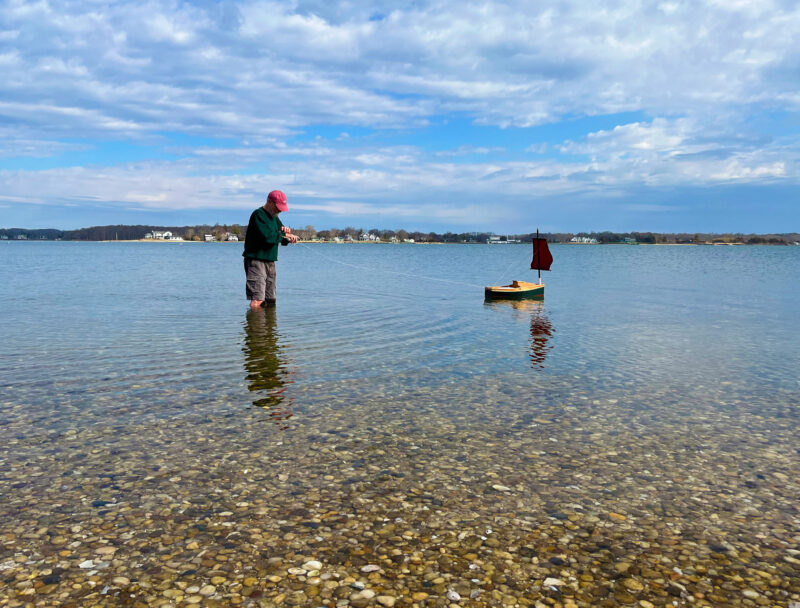
And the wind bears her away—at least to the end of a tether. If these light-air-fair-wind-flat-water conditions were to last indefinitely, my back-of-the-envelope calculations say CROW would reach Europe in about nine weeks. The Gulf Stream might shorten that.
I am of two minds about this. Yes, I would like the people I leave behind to know of my progress, of the success or failure of the venture. If CROW showed herself on some foreign coast, they might try to initiate a search. At the least, they could know where the journey ended, even if on some isolated, weather-wracked, and rocky shore.
And yet, I’m drawn to the idea of a simple disappearance, a vanishing, a lingering mystery of what happened. We sent him off in CROW. No one ever learned what happened. Perhaps he’s still at sea. Perhaps he’s lost on some coast. Perhaps his boat is on someone’s mantelpiece, and he still aboard. Perhaps he’s in the abyss of the ocean. No one knows. Mysteries have a long life. I still cannot help but wonder what happened to Henry Hudson, John Cabot, and Amelia Earhart.
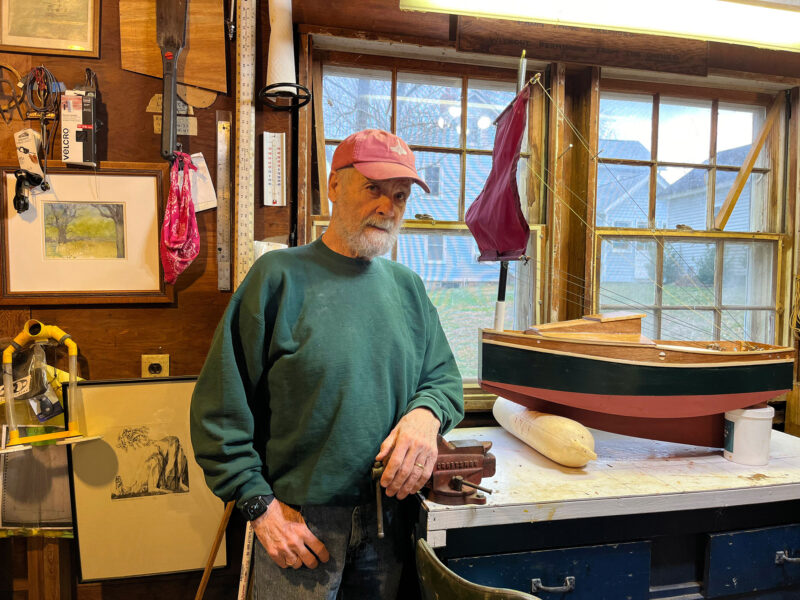
The author and his creation.
There is, of course, another possibility: a burlesque ending, the kind the gods seem to enjoy. Sometimes the prevailing winds don’t prevail, and things that are expected to sail eastward are driven west. A stretch of weather like that, with lots of east wind, would send CROW ashore in New England or Nova Scotia. Consider the Long Island high-school class that, at their teacher’s suggestion, tossed a message in a bottle into the Atlantic Ocean in 1992. It wasn’t found until 2024. In its 32-year journey it traveled to Shinnecock Bay, also on Long Island, a scant few miles from its launching point.
Well, that could happen. Maybe I won’t care.![]()
CROW Particulars
Length: 31″
Beam: 12″
Draft: 7 1⁄4″
Ballast: 7 lbs 8 oz
Displacement: 17 lbs (empty weight)
Sail area: 268 sq in
Andrew Fetherston, born in New York City, has owned boats since he was 11, including eight (not including CROW) that he built himself since retiring from a career in journalism. He is an artist and the author of two books. He worked on tugboats, freighters, and railroads in his youth. He has three grown children and eight grandchildren. He and his wife, the writer Amanda Barton Harris, live in Manhattan, Shelter Island, and Pestillac, France.
If you have an interesting story to tell about your adventures with a small boat, please email us a brief outline and a few photos.
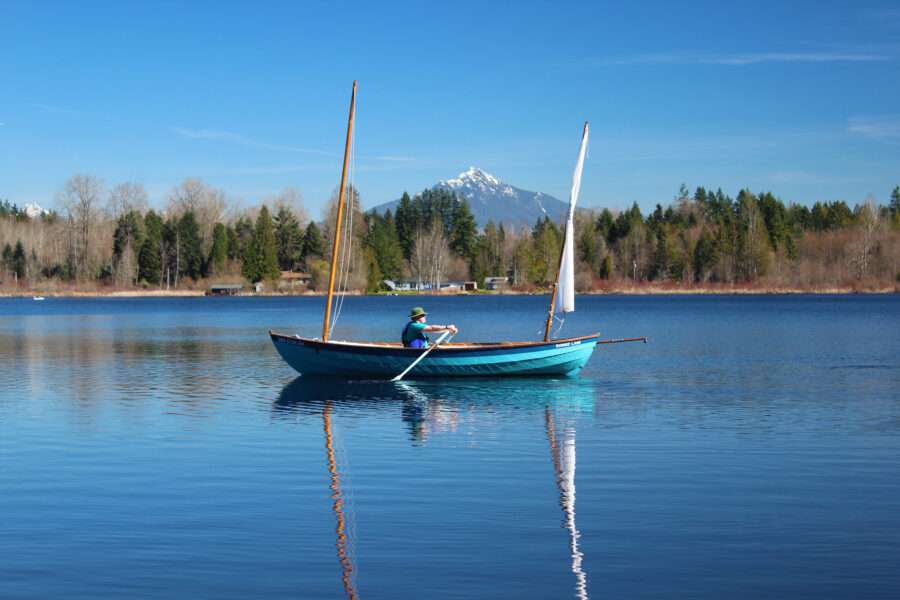
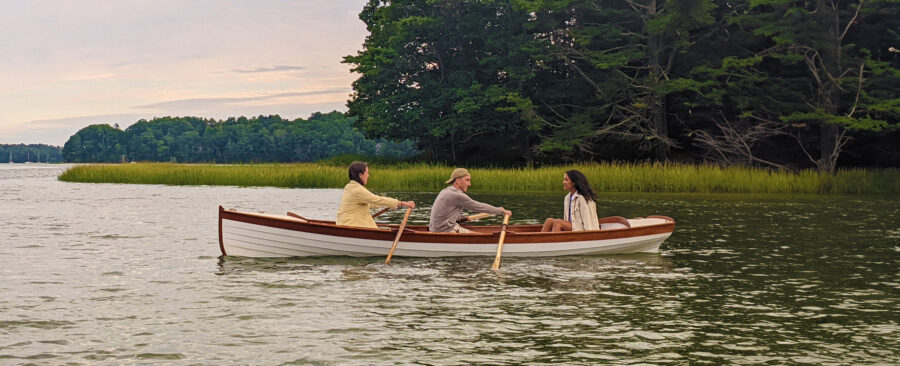
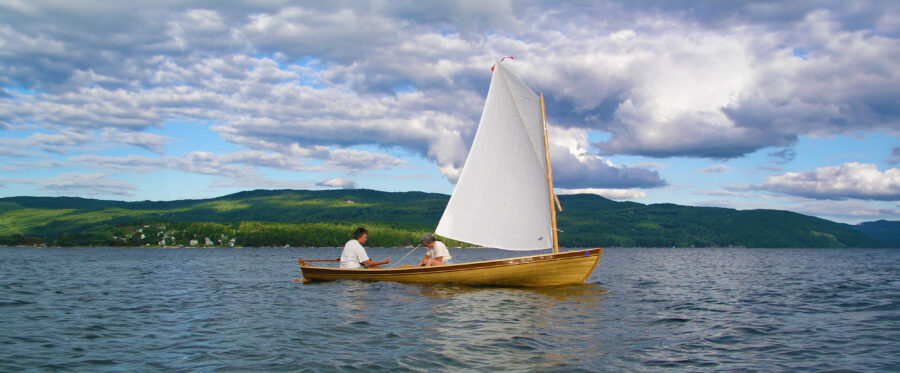
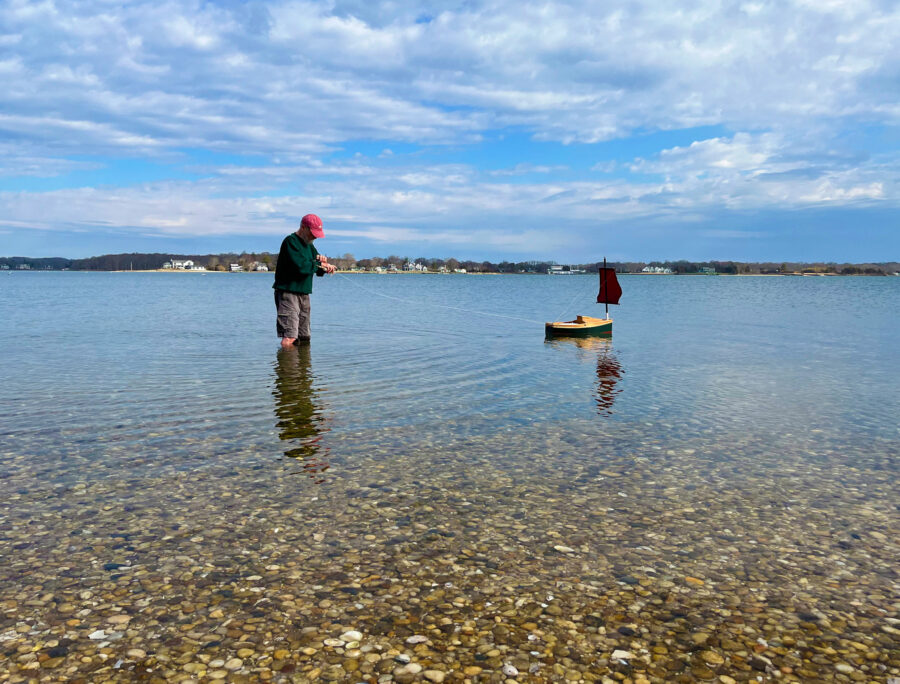
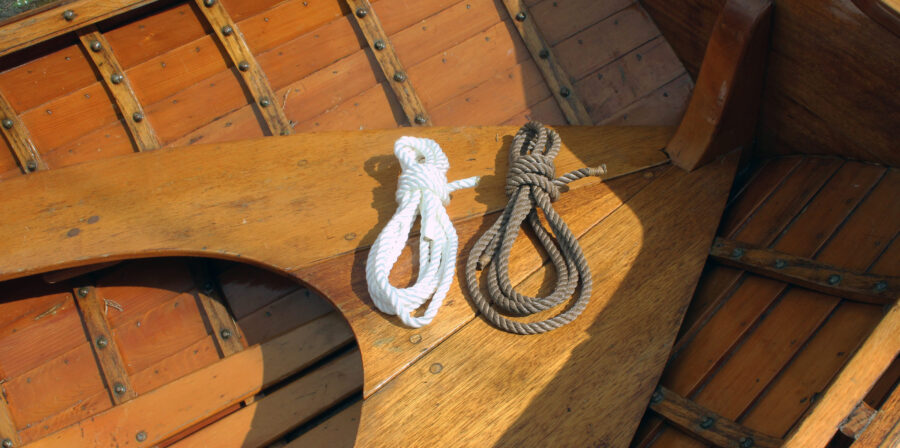
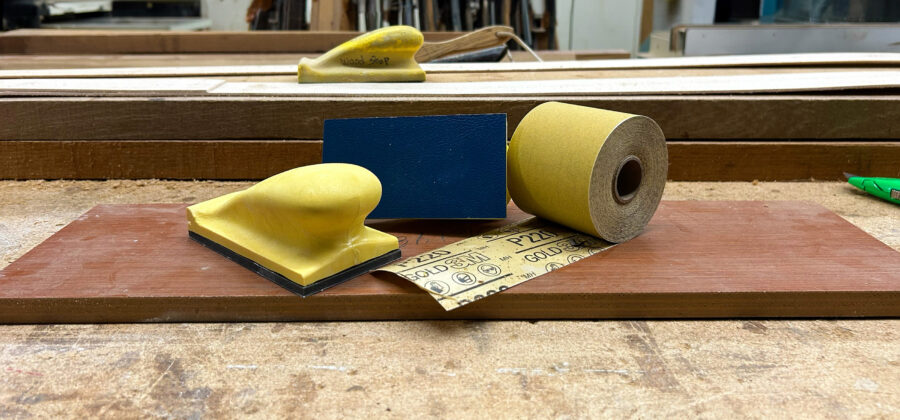
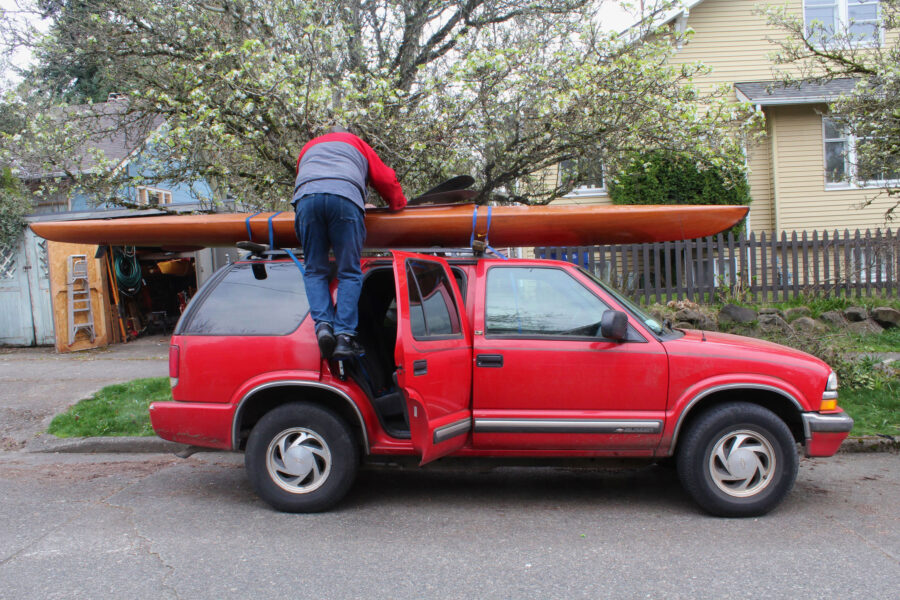
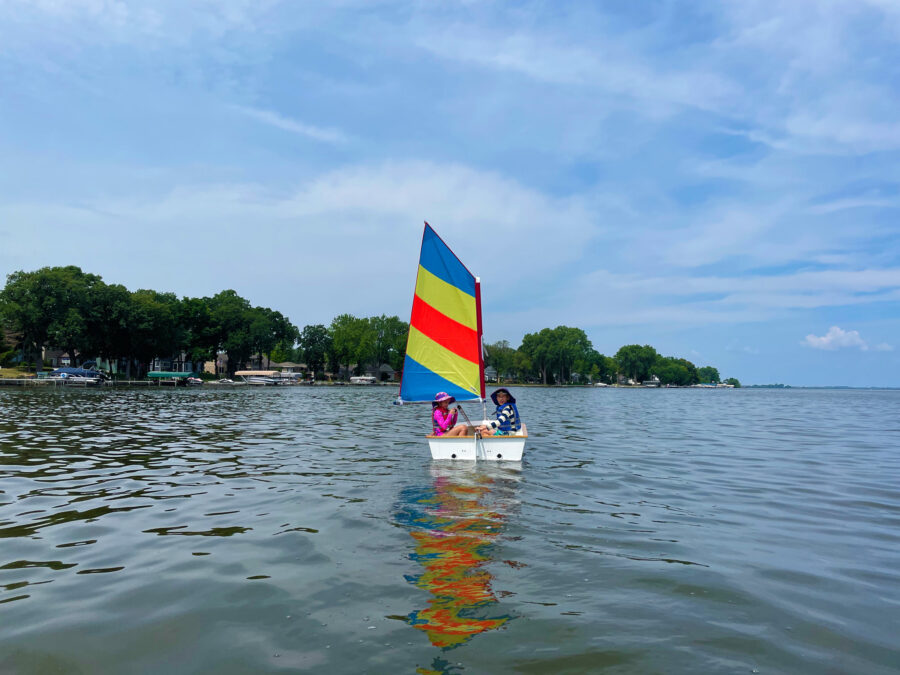
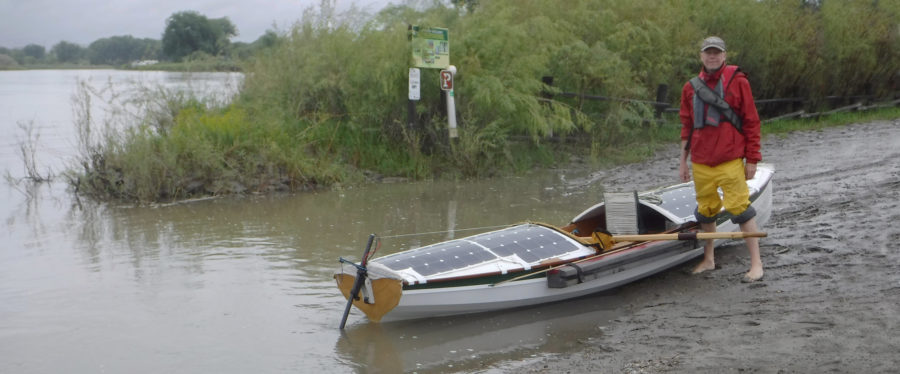
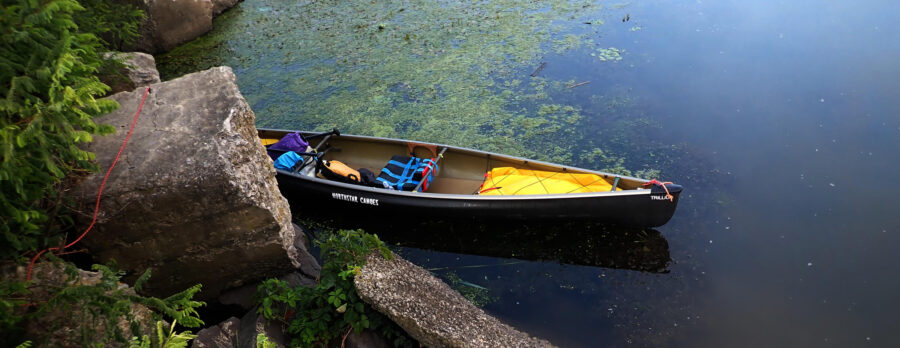
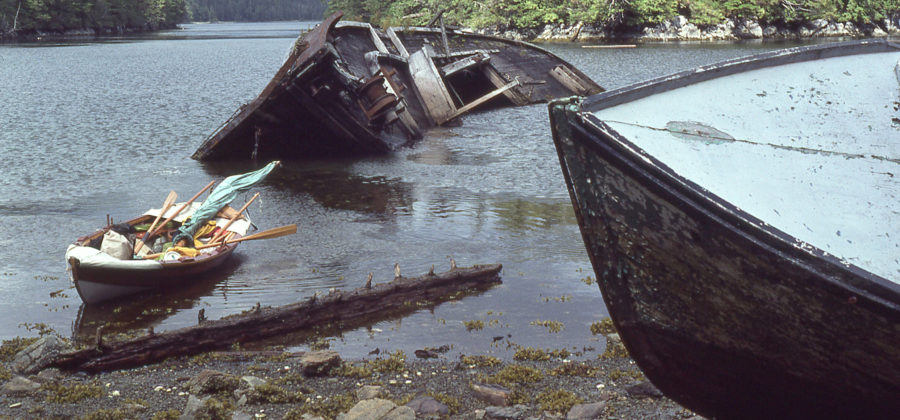
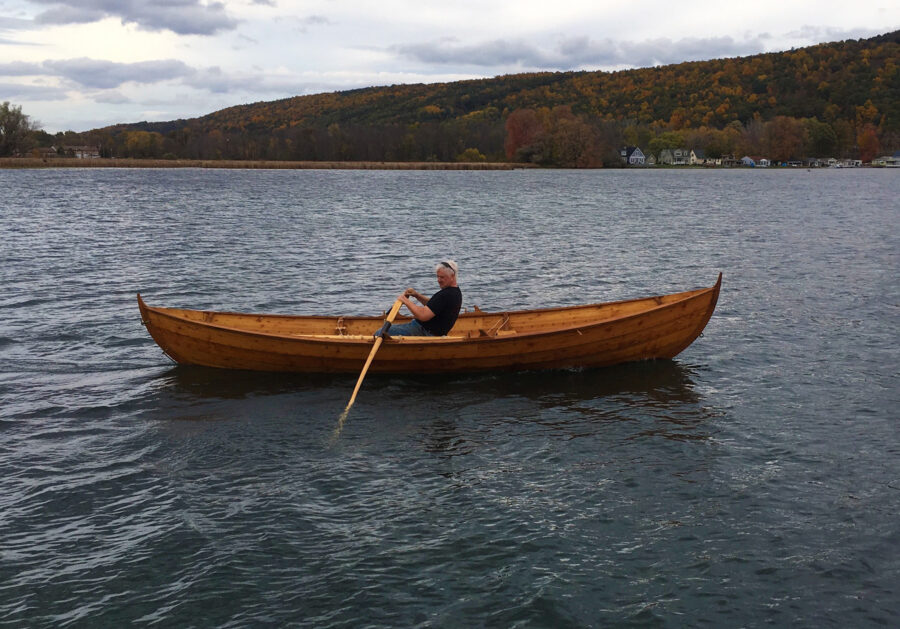
Is is appropriate to wish “good luck” for something like this? I cannot say. Perhaps, then, “Fair winds and calm seas.”
I am entranced by this idea. It would be a real prvilege to cross paths with you somewhere. You better not be in a hurry because the yarn will take some time.
I’m all ears (for as long as they continue to function) to hear the yarn.
Thanks for the delicate phrasing and kind wishes. See you (maybe) on the other side
A wonderful read. And a fabulous musing on our mortality and how our remains may carry on. In the meantime I will launch my Surfski kayak and watch how those Mergansers on the other side of the channel are feeding.
Tim
Don’t waste a moment — this isn’t a rehearsal. Enjoy those mergansers while you can.
Drew,
I’m about to begin construction on cremation urns for my wife and me, and your story has inspired me to think beyond just a couple of wooden boxes. Thanks for sharing your future adventure plan with me.
Karl — Good luck with your project — I’d be delighted to see the results.
Well done, old son. I wish you all the best which ever way you go. Don’t dismiss the crows; that is almost beyond coincidence.
As you know, crows in several traditions can cross between the kingdoms of the living and the dead. Who knows what they’ve seen over there?
An article and story that grabbed me as my wife and I got back from our daily after dinner walk. I’ve been playing with boats; building and tinkering since I was around five when I would make the most horrendous looking scrap wood (or plastic, or whatever was around) “boats” to tow behind whatever sailboat we had at the time. My Dad would happily indulge me in this. The majority of my creations would invariably make better forward progress in an inverted orientation much to my repeated frustration.
As I start to enter a phase in life that I’ve heard others refer to as the youth of my senior years (turned 55 last week), the whisps of mortality’s longs arms become just a little more real each year.
I love this idea and despite being a heavy thinker and getting lost in the weeds of thought on far too many projects this never occurred to me. Thank you for such a well-shared build and plan.
Fair winds and following seas.
I think you should include a message for the finders of your little ship.
Where and when did you start from would be nice. Do you want to be planted with the boat? Made into a planter? Burned again with boat?
Etc., etc., etc. It would be the kind thing to do for The Finder.
Daniel — The journey’s begun; time to start overplanning. Best of luck.
Thank you for this wonderful story. Turning 78 this year it tells me to start building my probable last boat, a smaller version of my Chebacco. We might meet.
jan doddema
Jan — I look forward to our eventual conversation. Which version of Chebacco? Departing what port?
Thank you very much for your article. I too have thought of things like you discuss. I have told my family that they should just put me in one of my boats and tow it out to sea and release it. A burning boat with me dead in it also is an idea I have expressed. All in all, I like your solution best. I am 83 and have indicated on my driver’s license that I want all my organs donated to science. I believe my sons will get the cremated remains of what is left. I hope to follow in your path in a very small boat securely ensconced for a long voyage.
Thank you again,
dale
Dale — Where will you be sailing from, and what’s your hoped-for destination?
All best wishes
I live and sail in the Tampa Bay area. Departure would be well off shore from Tampa Bay. Hoped-for destination is “I do not care” maybe Mexico. I have sort of harbored a wish to sail there over the years.
If you could provide any more plans or details, I would appreciate it. I would be happy to pay for shipping costs. Hopefully, the Small Boats Nation folks would provide my email to you so we could communicate further.
Thank you for your best wishes. I wish you the same.
Such a fascinating idea. Your prose is as wonderful as your art. I hung on every line. The part about the crows certainly makes one think. It reminded me of a line from one of my favorite singer/songwriters, John Prine, “For so long, the raven at my window was only a crow.”
Gordon, many thanks for the kind words
What a great story. Personally, I think no satellite tracking, you should go beyond the horizon, to voyage to who knows where. It would be lovely to see a satellite track, but I think being tracked would kind of make letting go harder. Good sailing.
Thank you for the lovely contemplation / doing essay.
It’s a poetic idea, but imagine what happens to the joy of some child in say Ireland finding a lovely toy boat, then having to deal with someone’s remains.
I agree with Robert. It seems a bit macabre to me.
Thank you.
May I suggest including a little bottle of your fav brew so the finders can toast your memory, and boat. As a beekeeper, I’d include a stainless flask of mead, half filled so it floats if the boat is wrecked and with a brief explanation and maybe link to your website for further info if someone wanted.
Maybe an idea to make arrangements for your Facebook page and website too.
Happy travels,
Noel
Pushing 80 myself, and I have thought that I would like my body to be sewn into a cotton-canvas bag with a chunk of cement at the foot end, then taken out to sea. There it would be placed on a plank which itself would be laid on the bulwark of the vessel bearing my remains. When the proper location is reached, the end of the plank is lifted and I slide into the sea to become fish and crab food. I understand that cremation uses a ton of energy, and of what use would my ashes be to this planet?